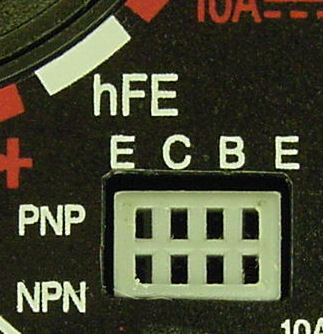jplebre
Well-known member
- Joined
- Nov 3, 2012
- Messages
- 617
Hi
If your DMM has a HFE socket, simply turn the weel (or the menu) and install them in this socket

BAsically, the 3708 are NPN (Not-Pointing-In and the letters mean each of the legs/connectors. (check datasheet, simply google for 2n3708 and whatever manufacturer you got for and look at the pinout (eg. CBE when looking at the transistor on the flat side).
and the letters mean each of the legs/connectors. (check datasheet, simply google for 2n3708 and whatever manufacturer you got for and look at the pinout (eg. CBE when looking at the transistor on the flat side).
Try and match them. And make sure you get hfe>250 for the required ones (See BoM).
Alternatively, you can get an Atlas Peak http://www.peakelec.co.uk/acatalog/jz_dca55.html worth it if you think of making more clones and neve-esk stuff etc
If your DMM has a HFE socket, simply turn the weel (or the menu) and install them in this socket

BAsically, the 3708 are NPN (Not-Pointing-In
Try and match them. And make sure you get hfe>250 for the required ones (See BoM).
Alternatively, you can get an Atlas Peak http://www.peakelec.co.uk/acatalog/jz_dca55.html worth it if you think of making more clones and neve-esk stuff etc







![Soldering Iron Kit, 120W LED Digital Advanced Solder Iron Soldering Gun kit, 110V Welding Tools, Smart Temperature Control [356℉-932℉], Extra 5pcs Tips, Auto Sleep, Temp Calibration, Orange](https://m.media-amazon.com/images/I/51sFKu9SdeL._SL500_.jpg)
















